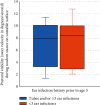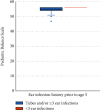Chronic Effects of Pediatric Ear Infections on Postural Stability
- PMID: 33628279
- PMCID: PMC7899764
- DOI: 10.1155/2021/6688991
Chronic Effects of Pediatric Ear Infections on Postural Stability
Abstract
Background: Ear infections in children often cause abnormal postural stability. However, the long-term effects of recurrent ear infections on postural stability have not been investigated.
Purpose: The purpose of this study was to examine the long-term effects of multiple ear infections on pediatric postural stability.
Methods: Forty children aged 10-12 years were divided into two groups (18 participants with a history of tympanostomy tubes and/or 3 or more ear infections prior to age five and 22 participants without a history of tympanostomy tubes and/or 0-2 ear infections prior to age five). Computerized Stability Evaluation Test (SET) and noncomputerized postural stability were measured for all participants.
Results: A significant difference was found in median postural stability scores in the SET during a tandem stance on an unstable surface between the two groups (median (minimum, maximum) of 9.1 (1.4, 11.4) versus 5.8 (1.7, 12.8), p = 0.04). In addition, there was a significant difference in median Pediatric Balance Scale scores between participants with versus without ear infection (54 (47, 56) versus 56 (55, 56), p = 0.001).
Conclusions: Results suggest that children ages 10-12 with a history of tympanostomy tubes and/or 3 or more ear infections prior to age five have decreased postural stability.
Copyright © 2021 Ohud A. Sabir et al.
Conflict of interest statement
The authors declare that they have no conflicts of interest.
Figures
References
-
- Robb P. J., Williamson I. Otitis media with effusion in children: current management. Paediatrics and Child Health. 2016;26(1):9–14. doi: 10.1016/j.paed.2015.09.002. - DOI
LinkOut - more resources
Full Text Sources
Other Literature Sources



